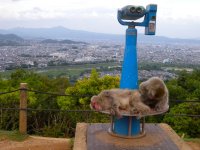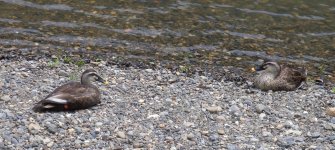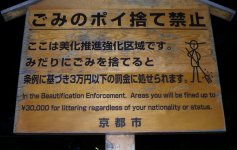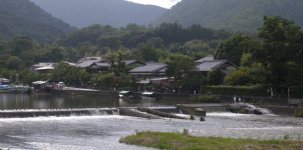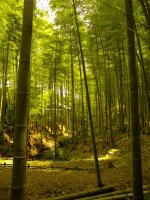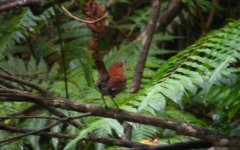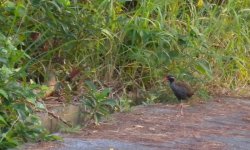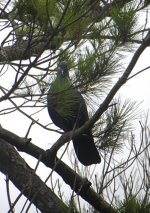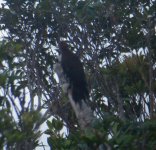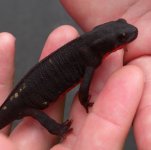MKinHK
Mike Kilburn

Kansai Airport and Kyoto
Thursday 4th July
Having got up at 5:00am Carrie and I arrived at the vast but mostly empty Kansai Airport from Hong Kong on the cheerfully cheap but painfully early Air India flight at 1:00 pm. Japan’s Shinkansen bullet trains may be the wonder of the world, but when your overtired and underfed their local trains take FOREVER!
Despite the pedestrian speed there were at least a few birds to be gleaned from the odd park, rice field and overhead wire. Most prominent were the coal-black Carrion Crows, mostly in pairs, and somehow managing to lurk and swagger at the same time – the very picture of the bullying kleptocrat. Barn Swallows, the odd White-cheeked Starling and Brown-eared Bulbuls popped up from time to time, along with four or five pairs of Oriental Turtle Doves. A couple of Great Egrets showed up superbly against the fresh green rice on one of the larger patches of paddy between the houses. Two Grey Herons flew north, and another shared some sort of large industrial frame with an unexpected adult Black-tailed Gull. The best bird was probably the Grey-headed Lapwing that came off a field somewhere between Osaka and Kyoto.
Friday 5th July
After a leisurely start we headed out to Arashiyama – a quieter suburb of Kyoto with several world-class pieces of cultural heritage on the western edge of the city. The walk through a massive grove of tall bamboos was atmospheric, if largely birdless, but the park next to the river began to deliver. Several Brown-eared Bulbuls called before finally showing themselves, while the local Japanese White-eyes looked duller and slightly larger-billed than the race we get in Hong Kong. Barn Swallows hawked over the river, which held a couple of pairs of Chinese Spotbills, half-a-dozen Great Cormorants, a couple of Little Egrets and singleton Great Egret and Grey Heron. A couple of Black Kites wheeled across the steep, well forested hillsides, and while looking across the river and eating fabulous cold soba noodles a fine Japanese Wagtail – just my second ever - dropped onto a grass-covered island in mid-stream.
After lunch we plunged back in to the heat and headed up the winding path to Monkey Mountain. Despite the humidity it was cooler, but rather birdless in the shade of the forest. Calling Brown-eared Bulbuls and Oriental Turtle Doves competed warily with the short-tailed Japanese Macaques for food. This monkey feeding is better organized than any I’ve seen. The humans can buy food inside a carefully closed hut and fed the monkeys diced apple or peanuts through wire across the windows. The big surprise here was seeing the shining blue back of a Common Kingfisher disappearing into the trees from the edge of the pond by the feeding station.
A rest stop at the bottom of the hill provided the real highlight of the day as first a family party of Japanese Tits and some Japanese White-eyes and then a gang of young Long-tailed Tits came feeding through the riverside trees. I was surprised at how broad and brown are the facial markings of the latter, reminding me strongly of Sooty Tits from central China. They fed close-by for a good quarter of an hour. Before they moved on I was delighted to find first a washed-out-looking juvenile Varied Tit and then a tiny Japanese Pygmy Woodpecker trailing along with the mixed flock that now numbered well over 50 birds. A solitary Grey Wagtail picking its way along a concrete-sided stream between two rows of houses and my second unidentified falcon of the day flying away from the train drew proceedings to a close.
Cheers
Mike
Thursday 4th July
Having got up at 5:00am Carrie and I arrived at the vast but mostly empty Kansai Airport from Hong Kong on the cheerfully cheap but painfully early Air India flight at 1:00 pm. Japan’s Shinkansen bullet trains may be the wonder of the world, but when your overtired and underfed their local trains take FOREVER!
Despite the pedestrian speed there were at least a few birds to be gleaned from the odd park, rice field and overhead wire. Most prominent were the coal-black Carrion Crows, mostly in pairs, and somehow managing to lurk and swagger at the same time – the very picture of the bullying kleptocrat. Barn Swallows, the odd White-cheeked Starling and Brown-eared Bulbuls popped up from time to time, along with four or five pairs of Oriental Turtle Doves. A couple of Great Egrets showed up superbly against the fresh green rice on one of the larger patches of paddy between the houses. Two Grey Herons flew north, and another shared some sort of large industrial frame with an unexpected adult Black-tailed Gull. The best bird was probably the Grey-headed Lapwing that came off a field somewhere between Osaka and Kyoto.
Friday 5th July
After a leisurely start we headed out to Arashiyama – a quieter suburb of Kyoto with several world-class pieces of cultural heritage on the western edge of the city. The walk through a massive grove of tall bamboos was atmospheric, if largely birdless, but the park next to the river began to deliver. Several Brown-eared Bulbuls called before finally showing themselves, while the local Japanese White-eyes looked duller and slightly larger-billed than the race we get in Hong Kong. Barn Swallows hawked over the river, which held a couple of pairs of Chinese Spotbills, half-a-dozen Great Cormorants, a couple of Little Egrets and singleton Great Egret and Grey Heron. A couple of Black Kites wheeled across the steep, well forested hillsides, and while looking across the river and eating fabulous cold soba noodles a fine Japanese Wagtail – just my second ever - dropped onto a grass-covered island in mid-stream.
After lunch we plunged back in to the heat and headed up the winding path to Monkey Mountain. Despite the humidity it was cooler, but rather birdless in the shade of the forest. Calling Brown-eared Bulbuls and Oriental Turtle Doves competed warily with the short-tailed Japanese Macaques for food. This monkey feeding is better organized than any I’ve seen. The humans can buy food inside a carefully closed hut and fed the monkeys diced apple or peanuts through wire across the windows. The big surprise here was seeing the shining blue back of a Common Kingfisher disappearing into the trees from the edge of the pond by the feeding station.
A rest stop at the bottom of the hill provided the real highlight of the day as first a family party of Japanese Tits and some Japanese White-eyes and then a gang of young Long-tailed Tits came feeding through the riverside trees. I was surprised at how broad and brown are the facial markings of the latter, reminding me strongly of Sooty Tits from central China. They fed close-by for a good quarter of an hour. Before they moved on I was delighted to find first a washed-out-looking juvenile Varied Tit and then a tiny Japanese Pygmy Woodpecker trailing along with the mixed flock that now numbered well over 50 birds. A solitary Grey Wagtail picking its way along a concrete-sided stream between two rows of houses and my second unidentified falcon of the day flying away from the train drew proceedings to a close.
Cheers
Mike
Attachments
Last edited:




